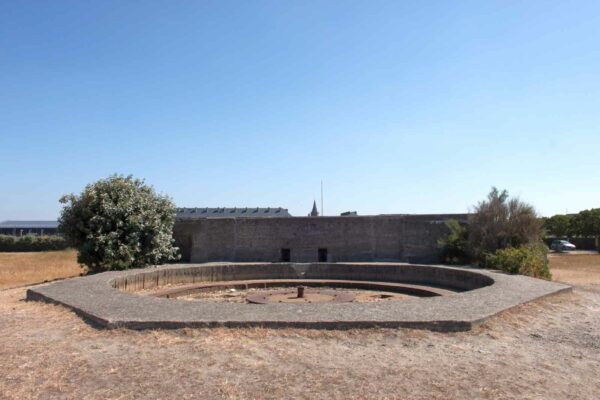First impression of Freie Küste

Bunker of Seeziel-Batterie ”Pointe du Roc” overlooking Mont-Saint-Michel bay
Normandie
Stahlbeton global positioning map –
Freie Küste
Coastal areas between the ports in Normandy needed defences
Although considered less important these vast coasts were strengthened as well. As a result, a considerable amount of bunkers was built by the German occupier. To support the coastal fortifications other facilities were installed as well.
Beach obstacles, barbwire and anti-tank obstacles became visible, minefields were laid.
Short description
Along the free coasts bunkers were constructed for different purposes
Stahlbeton – What is left today
Part of Coastal Defence Area ”E2”.
The Freie Küste or Free Coast between Le Tréport and Dieppe consisted of the former Stützpunktgruppe Penly. It was a rather small sector and not heavily fortified. The first position can be found in Mesnil Val Plage, the other positions in Criel Plage and Berneval-le-Grand.
The numbering in this region is indicated with the abbreviation Pen.
All photos are made by Stahlbeton.nl
Part of Coastal Defence Area ”E2”.
The Free Coast between Dieppe and Fécamp mainly consisted of the former Stützpunktgruppen Ste Marguerite and St Valéry en Caux. Besides the 622 standing up at Marg 03 and nice preserved bunkers at position Va 06 and Va 07, this area does not contain real highlights.
The fortified positions in this sector were indicated with the abbreviations Marg and Va. For other positions such a designation remains unknown.
All photos are made by Stahlbeton.nl
Coastal Defence Area ”F”.
This Free Coast between Fécamp and Le Havre can be considered as quite an extensive area. In contrast to the distance, the sector was built up with relatively few defences. The first position can be found in St-Léonard (76400), others can be found scattered along the coast. The most interesting site of them all must be the Luftwaffe Station ”Auerhahn” on Cap d’Antifer.
The fortified positions recevied no designation except those around Etretat. They were indicated with the abbreviation Et.
All photos are made by Stahlbeton.nl
Coastal Defence Area ”G”.
After Stützpunktgruppe Villers the defence units have no designation. For example, the former battery at Champmarin la Pómone (14640). More south we reach the region of Cabourg which was a small Stützpunktgruppe as well. Nothing much remains from this former strongpoint group.
Most of the positions within this area were designated with the abbreviation Cab.
All photos are made by Stahlbeton.nl
Part of Coastal Defence Area ”H1”.
At Franceville we reach the coastal fortifications along the famous D-Day beaches. The resistance nests and strongpoints covered the beaches which became known as Sword beach and Juno beach. German sector H1 started at the interesting strongpoint ”Stp. Franceville” and followed the coast all the way up to ”Stp. Ver-sur-Mer”. In contrast to the distance, this sector was built up with a relatively high number of defences.
The defence units were mostly designated with numbers.
All photos are made by Stahlbeton.nl
Part of Coastal Defence Area ”H2”.
After Ver-sur-Mer we keep following the coastal fortifications along Gold beach and Omaha beach. German sector H2 started at the strongpoint ”Stp. Asnelles” and the coastal area was built up with quite a lot of defences as well. Some of them became well known such as naval battery “Longues” and army battery “Pointe du Hoc” on the Pointe du Hoc. At Brévands the last fortified position of this sector can be found (W.N. 99).
The defence units were mostly designated with numbers.
All photos are made by Stahlbeton.nl
Part of Coastal Defence Area ”H2”.
After Ver-sur-Mer we keep following the coastal fortifications along Gold beach and Omaha beach. German sector H2 started at the strongpoint ”Stp. Asnelles” and the coastal area was built up with quite a lot of defences as well. Some of them became well known such as naval battery “Longues” and army battery “Pointe du Hoc” on the Pointe du Hoc. At Brévands the last fortified position of this sector can be found (W.N. 99).
The defence units were mostly designated with numbers.
All photos are made by Stahlbeton.nl
Part of Coastal Defence Area ”J1”.
German sector J1 started at “W.N. 100” and was situated in a village named le Grand Vey (50480).`Here we enter the Cotentin Peninsula and keep following the coastline further north in the direction of Cherbourg. The last sector of the Normandy landings is here, code named Utah beach. The coastal area is built up with many defences.
The defence units were mostly designated with numbers.
All photos are made by Stahlbeton.nl
Part of Coastal Defence Area ”J1”.
This part of sector J1 started at “W.N. 301” and was situated near Quervière Bay (50440). Here we enter La Hague in the northwest of the Cotentin Peninsula and leave Festung Cherbourg behind us. Besides infantry positions and army coastal batteries, the area consisted of quite a few Luftwaffe radar stations as well. The last resistance nest of this sector
is located in Barneville-Carteret.
The defence units were mostly designated with numbers.
All photos are made by Stahlbeton.nl
Coastal Defence Area ”J2”.
This sector started after Barneville-Carteret and ran further south in the direction of the Mont-Saint-Michel Bay. It passed port city Granville (50400) and it ended near the tidal island of Mont-Saint-Michel. Fortified position “Stp. 20” in and around Granville received the highest number of fortifications and is well worth visiting.
The defence units were designated with numbers.
All photos are made by Stahlbeton.nl
W.N. Gr. 1
W.N. Gr. 2
W.N. Gr. 4
W.N. Gr. 4
W.N. Gr. 4
W.N. Gr. 5 – Seeziel-Batterie 3./M.A.A. 608 ”Granville”
W.N. Gr. 6
W.N. Gr. 10
W.N. Gr. 11
W.N. Gr. 12
